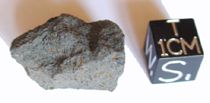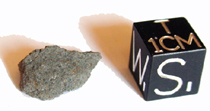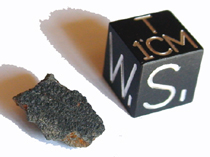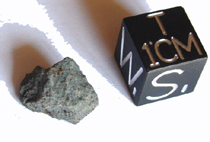CO Group
The meteorites of this group are named for their type specimen Ornans
that fell in France in 1868 - by that, not far from our home in the French
department Doubs. There are only about 25 members of this group if we
don't count all the probable pairings - especially from the Dar al Gani
region, Libya, where many COs have been found. It's more than probable
that all Dar al Gani COs arrived in one or two distinct falls.
All members of this group of carbonaceous chondrites belong to the
petrologic type 3, and they show a certain relation to the CV group when
it comes to chemistry and composition. Therefore, many researchers suppose
that the CV and the CO group represent a distinct clan of carbonaceous
chondrites that formed in the same region of the early solar system.
However, the conditions under which the COs formed must have been
different from the conditions under which the CVs formed because there are
obvious differences.
Moss
CO3.6
Fell July 14, 2006, ~10:20 hrs in Norway
|
 
|
|
|
|
Moss -00
fragment with a tiny patch of crust
8.37gr
$2100 |
|
|
|
|
|
|
|
Moss -01
fragment
1.044gr
SOLD
|
|
|
|
 
|
|
|
|
|
|
|
 
|
|
|
|
Moss -02
fragment with suberb crust...
0.77gr
SOLD |
|
|
|
|
|
|
|
Moss -03
fragment
0.848gr
SOLD
|
|
|
|
 
|
|
|
|
|
|
|
|
|
|
|
|
|
|
|
|
|
|
|
|
|
|
|
|
|
|